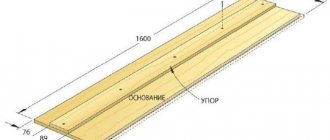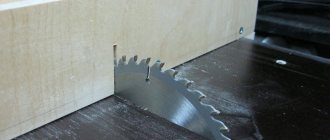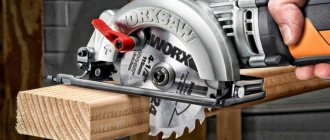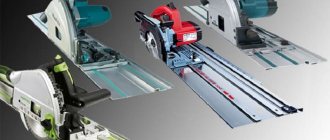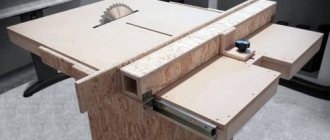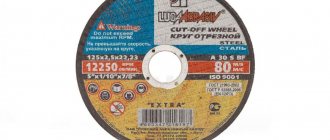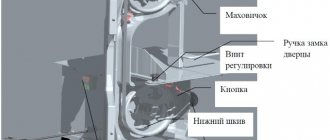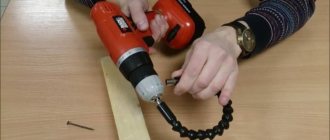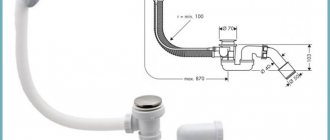Purpose
Depending on the type of disk, the following can be processed:
- wood of various species;
- wood products - chipboard sheets, OSB, plywood, laminated flooring and other similar materials;
- polymeric substances and products made from them, for example, organic glass, polystyrene;
- natural stone material, such as marble;
- soft metals – aluminum, copper alloys;
- products based on iron alloys - pipes, corrugated sheets, etc.
A cutting tool has certain characteristics, parameters, dimensions, purpose, and properties of the material from which it is made.
Basic parameters of a circular saw blade
Outer (external) diameter
It is determined by the internal size of the protective casing - a blade with a larger diameter will not fit on a saw with smaller casing dimensions. The main dimensions of cutting tools for hand-held circular saws are in the range of 130-250 mm. The outer diameter does not have a significant effect on the cutting speed, but determines the cutting depth. As the cut increases, the engine is significantly loaded, and the metal of the disk and the workpiece itself are heated.
Internal, landing diameter
It has several sizes: 16, 20, 22, 30, 32. An important parameter is that the diameter must correspond to the size of the power shaft on the saw for which the blade is selected. Some disk models have additional holes that secure the disk to pins.
Number of teeth on the disc
Affects parameters such as cutting speed and processing cleanliness. With a decrease in the number of teeth, the processing speed increases, the conditions for chip removal improve, but the cleanliness of the cut deteriorates. As the number of teeth increases, the cut becomes cleaner, but the load on the engine increases. Conventionally, according to their quantitative ratio, disks can be divided into three groups:
- a large number of incisors, in the range of 80-90 pieces;
- average quantity (40-80 pcs.);
- small quantity (10-40 teeth).
Discs with an average number of cutters are classified as the universal type. They can process soft and hard wood, make transverse and longitudinal cuts, and be used for processing various wood products.
Tooth inclination
Determined by the deviation of the cutting edge surface from the disk radius. When the deviation is towards the back side of the tooth, the inclination is called negative; when the inclination is on the reverse side, it is called positive. For longitudinal sawing, it is more advisable to use a tooth with a positive inclination, since during the processing process a kind of material capture occurs, the disk impacts the part, which contributes to faster cutting of the workpiece as a whole. The inclination of the tooth is divided into:
- standard tilt – the angle varies from 5° to 15°;
- positive, aggressive tilt is 15-20°;
- a typical negative angle ranges from 0° to -5°.
Tooth configuration
Each type of cutter is designed and manufactured to solve a specific task. Subdivided:
- Flat cutter - used for fast longitudinal cutting of soft or hard wood, designated FT.
- Replaceable cutter - has a sequentially alternating, replaceable inclination of the teeth in one direction or the other. The cutters give an even and fairly clean cut. Used for cross and longitudinal cutting of wood, processing plywood, OSB, chipboard and composite boards, indicated by the ATB symbol.
- A combination cutter is a sequential change of groups from a combination of four replaceable cutters (ATB) and one flat cutter (FT). Designated as Combi. This type of disc is considered universal due to its ability to perform different types of cuts.
- Trapezoidal flat cutter - made of successive flat teeth. The higher one is designed as a trapezoid, the lower one is flat. It is used for processing wood and products made from it, for polymer materials and soft non-ferrous metals. Designated TCG.
- Replaceable cutter with large beveled side - designed for processing materials prone to splintering, as well as for finishing crosscuts. Denoted HiATB.
Disc thickness
Determines the actual cutting width. The standard size is 3.2 mm. In addition, the thickness of the disc affects the strength of the cutting tool itself. Reducing the parameter leads to heavy operating conditions, overheating of the disk and failure. A larger size causes increased consumption of the processed material, that is, “translation into chips.”
Circular saws are used in processing various materials. Accordingly, the cutting tool is designed for specific tasks.
Mounting Diameter of Circular Saw Blade
How to choose a circular saw blade
?
To choose the right blade for a circular saw, you need to know its outer diameter
landing hole. It is also important what material you are going to cut. Let's look at these questions here.
As for the diameters of the disk , there is not much to talk about this fact, since the user himself must know what sizes are used on his tool. For hand-held circular saws, discs come with an outer diameter of one hundred and thirty to two hundred and fifty mm, with a seat of 16, 20, 30, 32, and fifty mm. It is very rare to find saws with a 25.4 mm seat. Diameter
A seat of fifty mm is usually found only in disks of two hundred and fifty mm.
On machines, the outer diameter of the disk
can be from two hundred and fifty to five hundred mm, and the seats are thirty-two or fifty mm.
On crosscut discs, the discs usually range from two hundred to three hundred and five mm. Find out the characteristics of circular saw attachments. Disc diameter is landing diameter. Also, saw blades for sawing aluminum with diameters of 355x25.4 mm are installed on cutting machines (or assembly saws or pipe cutters). disk dimensions in the instructions, or you can simply measure them with a regular tape measure.
READ How to Sharpen a Wood Disc on a Grinder
one hundred and forty types of circular saws from different manufacturers in one place. Tolerance for the bore diameter at the circular saw shaft. Click to view
As for the sawing material, there are saw blades for wood, but also for plastic, aluminum and not laminate. They differ in the shape of the saw tooth sharpening.
Wood blades are universal - for longitudinal, not cross-cutting, and there are finishing blades - only for transverse, but cleaner sawing of wood. The difference between these discs is the amount of cutting tooth. Tolerance for the bore diameter at the circular saw shaft. With universal discs it is much more difficult than with finishing discs. The simpler the size of the cutting tooth, the more confidently the disc moves during longitudinal sawing, nettles, and edging. Alas, the large tooth cuts roughly transversely. If you are sure that your main work will only involve longitudinal sawing, then you can safely take a circular saw blade with the largest cutting tooth. Circular saw blade mounting diameter. Breakdowns of the disk, saw and damage. When you need to saw, well, well, then you should buy a disk with a medium tooth size. But only for finishing cuts, take a disk with small teeth. This disc should not be used for longitudinal sawing, since it then cuts slowly, and when it does, it overheats excessively from such work. The size of the teeth affects the number of teeth on the disk. What, what, than just teeth, the fewer there are on the disk.
Saw blades. Review of technologies. One piece
Saw blades
.
The diameter of the blade can be a miter saw. Circular saw mounting diameter. Review of technologies. One part about how to choose a saw blade
. Two part video.
Laminate blades should be used when cutting laminate and any other laminated wood materials with a circular saw. They do not leave marks on the laminated surface, ensuring a smooth and clean cut edge.
To cut plastic and aluminum, use a special disc, which is called “For plastic and aluminum.” Its sharpening makes it easy to saw these fairly dense materials without melting the edges.
Most circular saw blades today come with a carbide tipped tooth. However, for wood there may also be discs without soldering with an appropriate tooth pattern, as on hand saws. Mounting diameter of a circular saw blade. Of course, they are becoming less and less common, since carbide discs last longer.
When choosing a disk, you should also look at its thickness, if it matters to you. The circular saw blade follows the disk and has a bore diameter. It happens that you need as little material as possible to be “eaten up” by sawing, so you may need a thin saw blade.
READ Rating of Wood Saw Blades
As for manufacturers of circular saw blades, it is better to purchase blades from well-known manufacturers of these circular saws themselves, for example, Makita, Bosch, DeWalt, etc. They are of the highest quality. True, they are quite expensive. For small volumes of work, you can also use inexpensive Chinese disks. There are also middle options, for example, .
These are the main points you need to know in order to choose the right circular saw blade. We hope this information was useful to you.
Source
Types of circular saw blades
Monolithic disk. They are made of high-quality high-carbon or high-speed steel. They are used for processing wood and products made from it, as well as for cutting polymer products. They have a number of advantages:
- inexpensive;
- simple sharpening of teeth - you can perform this operation yourself, without the presence of complex special devices;
- They are sharpened many times, therefore, they have a fairly long service life.
A disc with teeth that are reinforced with carbide brazing. The blade is made of durable tool steel. Brazing is steel alloys with a high content of tungsten or cobalt carbides. Thanks to this solution, these disks have become the most common. They have a number of advantages:
- allow cutting most of the known materials;
- no need to set the teeth;
- durable and reliable during operation;
- the service life from sharpening to sharpening is several times higher compared to a monolithic disc;
- give a cleaner cut;
- increase cutting speed;
- are produced in a wide range to solve all kinds of problems when sawing materials.
However, there is a significant drawback - such discs are relatively expensive and require special equipment for sharpening.
Recommendations for choosing a disk
When choosing a blade, you must take into account the technical parameters of the circular saw:
- engine power;
- maximum speed;
- mounting size on the motor shaft;
- inner diameter of the protective casing.
The engine power affects the type of disk - a negative angle, a large number of teeth create a large load on the engine, which will have to work in “peak” mode.
The number of revolutions or spindle rotation speed is interconnected with certain disk sizes that the manufacturer recommends. Installing a cutting tool deviating from the recommended ones can lead to abnormal operation, resulting in possible breakage of the disk, saw and damage to the material being processed.
The mounting dimensions of the disk (inner diameter) and the corresponding one on the motor shaft must match, otherwise the tool cannot be installed on the saw.
The external size of the disk cannot exceed the internal size of the casing - if this parameter is violated, the tool will not be installed on the saw.
The type of disk is influenced by a number of factors:
- type of work performed, material processed;
- device, design of cutting tool;
- number of teeth, their design.
Work performed and material processed. Since different discs are produced, it is necessary to decide on the types of operations (what types of cuts will be carried out), and also take into account what the cutting tool will process.
Depending on the type of operation and material, the type of disk is selected: monolithic or with carbide tips.
The processing mode and type of material determine the number of teeth, their type and inclination. The most popular is the average number of teeth with trapezoidal sharpening with a positive angle.
Selecting a circular saw blade
To choose the right equipment, you should take into account the type of material to be processed. Discs installed on a wood saw must match its operating speed. When choosing a circular saw blade, its main parameters are taken into account:
- Quality of packaging – original discs are packed in a flat branded box;
- manufacturer's corporate logo;
- all disc sizes are marked in the most visible place, near the mounting hole;
- maximum operating speed - indicated under the mounting hole;
- number of teeth and their inclination;
- obligatory application of labor protection symbols - the original cutting parts have images of protective equipment: gloves, glasses, noise-canceling headphones;
- direction of rotation of the equipment: pointer arrow;
- a schematic or letter designation of the material for which the disc is intended for sawing - for example, wood.
There is no single, international standard for disc labeling, so the manufacturer himself decides what information he needs to convey to the consumer by labeling.
A significant selection criterion is the quality of manufacture of the steel base itself. The steel must be ground and be as smooth as possible. Significant roughness of the cutting organ may indicate low quality of the product.
It is worth paying attention to the logic that the manufacturer usually adheres to. For example, if a tool has an operating speed of 8000 rpm, but it itself is rough, poorly polished, and does not have temperature compensation grooves, then what quality of such a tool can we talk about? High speed itself implies significant heating of the equipment during operation, which could be reduced by high-quality grinding and thermal compensation. If they are not there, then the “life” of such a working body is very limited.
Rating of saw blades for wood
Let's look at several working tools that were used by craftsmen of various levels. A vote was held among the masters, receiving the following rating:
- The fastest is a Bosch tool. It has 12 large teeth with pobedit tips, the size of the equipment is 190 × 30 mm.
- The cleanest cut is Metabo Precision Cut. Dimensions: 190 x 30 x 2.2 mm. Equipped with 48 teeth with pobedit tips. The WZ icon printed on the front side means that the tool can cut wood and wood-containing materials (fibreboard, chipboard, OSB, plywood);
- The thinnest and most accurate cut is CTM. Dimensions 190 × 30 × 1.1. ; 42 carbide cutters, high operating speed - up to 8000 rpm, and the presence of thermal compensation allow you to create thin, clean cuts in wood for materials based on wood.
The ratings given here are compiled by the masters based on their personal, subjective point of view. The rating is based on experience with this tool.
Disc quality
There are several signs by which you can almost accurately determine whether a product is of high quality or poorly made:
- The disc must be marked, and the inscription must be applied using a laser tool and not with paint.
- The blade must be subjected to a grinding and polishing procedure - the purity of the processing can be seen by looking at it if you “play” with the disc in the light.
- The cutting tool disk is subjected to balancing and calibration procedures - the operation is roughly reminiscent of balancing a car wheel. After such treatment, the cutting tool will not “beat” and there will be no vibration during operation.
- To compensate for possible temperature expansions, special slots are made on the disk, ending with small relief holes.
- Some manufacturers reinforce the disc with several circular stiffening rings.
- Another indicator of quality is the name of the manufacturer, its trademark. Today these are European, American, South Asian, Russian and Chinese manufacturers (listed in descending order of quality). By the way, some Russian manufacturers produce products comparable in some respects to European or American ones.
In general, choosing the right circular saw blade is almost a science. If you have no experience, then it is better to seek advice from professionals, especially those who have had the experience of working with a circular saw for at least 2-3 years.
Video about replacing a circular saw blade.
Related articles:
- Adjusting the carburetor of a chainsaw The carburetor is one of the components in the fuel supply system in an internal combustion engine. It is designed to form a mixture of fuel and air with adjustable supply into the chambers [...]
- Adjusting a chainsaw A chainsaw is a hand-held tool designed to work with wooden material. It is equipped with a gasoline internal combustion engine. It is a complex structural device. IN […]
- Attachments for mini-tractors A mini-tractor in agriculture is an indispensable friend and assistant. He has to cope with all sorts of jobs: digging up the soil, applying fertilizers, and spraying […]
- How to sharpen a chainsaw chain A saw chain is a cutting tool designed for cutting wood. It consists of sequentially located sharpened links connected by […]
General rules for sharpening a circular saw blade
The most important rule that you need to know and strictly follow when sharpening a circular saw blade with your own hands is to carefully inspect the saw. If the teeth have a factory shaped sharpening, then it is impossible to “correct” it after the cutting part has become dull. To properly sharpen such cutters you need special equipment. At home, it is impossible to make such equipment for a circular saw sharp again.
For working bodies with a positive inclination angle of the cutters, the feed limit angle must be taken into account. Changing this angle will change the depth the tool will cut into the material. Sawing will be jerky, jerky, and can even lead to damage to the material, equipment, and injury to the worker.
When sharpening yourself, it is best to use special sharpening machines for household use. They allow you to maintain the required sharpening angles and speed. The following will help you sharpen a circular saw with pobedit tips: a good eye, knowledge of sharpening angles, a steady hand, and brief touches of the cutting edge to the sharpening surface. The rotation speed of the sharpening tool is more than 3500 rpm, which can lead to loss of cutter strength. The equipment will be irretrievably destroyed.
